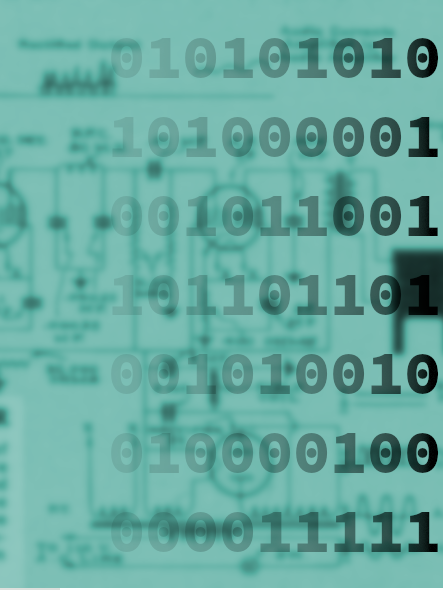
SDR allows to manipulate one of the fundamental forces of the universe, directly through digital signal processing done in software. CEL takes a decisive role in the understanding and implementation of SDR, which allows us to rapidly convert research projects into practical implementations, casting off the chains of simulation and applying bleeding edge research directly to the physical medium.
Kanalcodierung für die zuverlässige und effiziente Hochgeschwindigkeitskommunikation
linkResearch Areas
Channel Coding for Reliable High-Speed Data Transmission
Almost all the data communications (e.g., via mobile phones) include the transmission over an optical fiber-based backbone network. These networks form the back of today's digital infrastructure. In order to guarantee a smooth user experience, these networks need to fulfill very stringent requirements in terms of latency and error rates. The required error rates are less than 1 bit error per day, which, when considering the fact that future modems will most likely transmit more than 1 Tbit/s, amounts to an error rate of less than 10-17. Similar requirements are present in storage devices like hard drives and flash drives, in order to guarantee reliable data reconstruction. At the CEL, we investigate new approaches to realized channel coding system that delive on the one hand these low required error rates and on the other hand have low processing latencies and low decoder complexity for realizing energy-efficient transceivers.
Software Defined Radio and Cognitive Radio
The vision behind software radio is to realize a radio’s communication specific signal processing, e.g. modulation, channel equalization and channel coding, as far as possible in software. Ideally, customized hardware could be replaced by a general purpose processor with D/A- and A/D-converters and amplifiers. This allows for highly flexible usage of the hardware, as signal processing is carried out as algorithms on the general pupose processor.
The CEL has been continuously involved in SDR projects since 1996. Based on this experience, CEL is now pursuing the evolution of software radios towards cognitive radios. Cognitive radios are self-learning intelligent software radios which are able to monitor their environment and to adapt to the actual conditions such as standards, channel properties, etc.
Due to the vast software and hardware infrastructure available at the CEL, multiple research projects in the scope of software and cognitive radios are possible. Models and algorithms can be investigated using simulations. We have access to large software libraries to describe transmission systems. Additionally, the available hardware - Universal Software Radio Peripherals (USRPs) from Ettus Research - allow testing and experiment validation of the algorithms.
Dynamic Spectrum Sharing and Statistics
With increasing demand for mobile communications and new applications, efficient usage of the available spectral resources gains importance. Due to the current static assignment of frequency bands by regulatory bodies, the current communication demand often exceeds the available resources.
One approach to dynamically adapt the available bandwidth is the concept of spectrum pooling, where unused frequencies are exploited by overlay systems. To assure reliable operation of the licensed system, the secondary user has to monitor the allocation of the licensed system continuously and to decide whether the spectrum is occupied by the licensed system.
By using a secondary market approach and treating operators equally, real-time license auctions can balance varying traffic demands over time and simultaneously satisfy market related expectations of the operators.
Another method is the usage of cooperative relay networks where several users pool their resources to create virtual antenna arrays in order to achieve spatial diversity.
Ultra-Wideband
A radio technology is considered ultra-wideband if the ratio of its bandwidth to its center frequency is greater than 20%, or if its bandwidth exceeds 500 MHz. Favorable features of ultra-wideband include transceivers of high data rates, low complexity and low power consumption, localization capabilities and radar technologies. Furthermore, it enables the secondary use of radio spectrum, resulting in more efficient spectrum usage. INT's projects in ultra-wideband focus on baseband transmission using very short pulses and deal with interference analysis, interference suppression and low-complexity transceiver concepts.
Optical Sensors
Industrial sensors such as photoelectric switches are widely used in factory and logistics automation where they are exposed to strong optical and electrical interference. In cooperation with industrial partners, new methods and algorithms for signal generation, detection and signal analysis, based on methods of digital signal processing and communication technology, are developed in order to realize solutions for robust and intelligent optical sensors. The scope of the work covers optical spreading, interference analysis and mitigation, and low-complexity analog-to-digital conversion techniques.
Research Projects
Based on INT's experience on spectrum pooling gained in the HYEFF project and on its continuing work on SDR, CEL became a member of the E2R consortium working on End-to-End Reconfigurability. With its knowledge acquired in the MiniWatt project of the German Federal Ministry of Research and Technology, CEL also joined the PULSERS (Pervasive Ultra-wideband Low Spectral Energy Radio Systems) consortium. E2R and PULSERS are integrated projects within the 6. research framework program of the European Union. Currently, CEL is partner in the 7. research framework program project Wireless Interoperability for Security (WINTSEC).
Furthermore, CEL participated in the DFG funded projects TakeOFDM and UKoLoS, dealing with overlay systems and ultra-wideband communications, respectively, and is now working in the project OFDM-based Overlay Systems (OOS).
Further scientific investigations at INT, e.g., on software defined radio, satellite communications, digital signal processing and radio signal analysis, are sponsored by governmental agencies or industrial partners.

